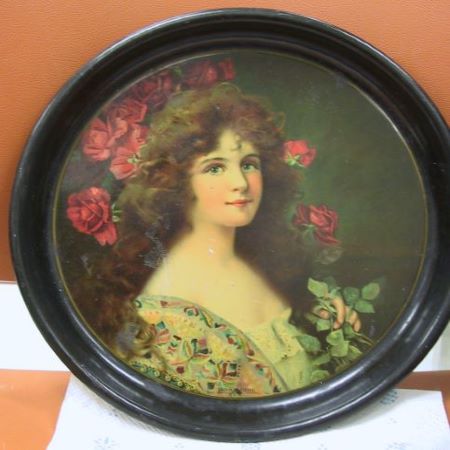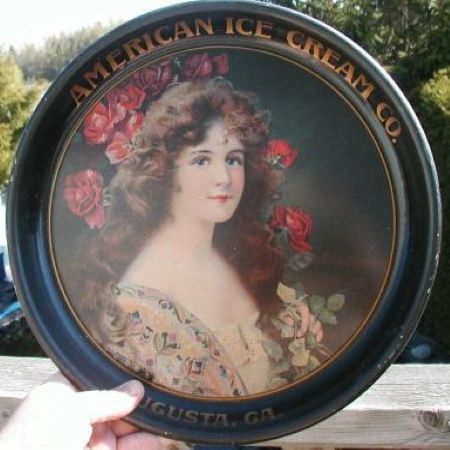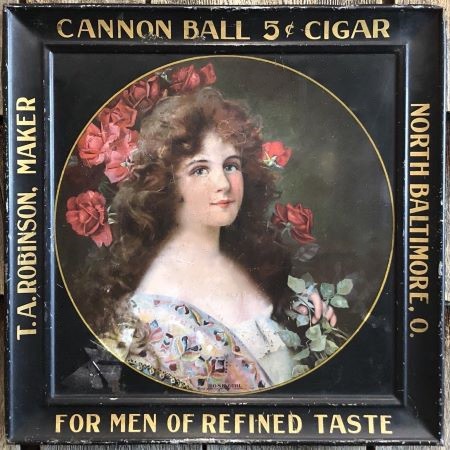The 'Stock' Exchange
American Art Works: No. 130 "Rose Girl"
American Art Works: No. 130 "Rose Girl"
Date: 1913 to 1921
Size: 13"
Type: Pie
Scarcity: Extremely Rare
Value: $$$ to $$$$
Condition & Brewer Dependent
Size: 13"
Type: Pie
Scarcity: Extremely Rare
Value: $$$ to $$$$
Condition & Brewer Dependent


Confirmed Brewer used Stock Trays
Non-Beer Related & Non-Tray Uses
General
“Rose Girl” No. 130 is similar in concept to it’s two predecessor “flower girl” designs, “Carnation Girl” (No. 105) and “Chrysanthemum Girl” (No. 111), all of which feature portraits of beautiful young women with a large arrangement of flowers. Although roses have appeared in numerous other designs, including red roses, this is the only design where they are all red. In Western culture the red rose is strongly associated with passionate, romantic love. The red rose began its illustrious symbolic history in Greek and Roman iconography, where it was tied to Aphrodite, or Venus, the goddess of love. Later, in early Christian times it became associated with the virtue of Virgin Mary. By the time Shakespeare rolled around it had already become a poetic standard that he, and later Robert Burns, both famously played with in their works. Throughout its long, storied history, the red rose still reigns as the ultimate symbol of passionate affection.
Like the woman in its immediate predecessor (No. 129, A Busy Wire) the subject here is in far more informal dress than previous “pretty lady” designs. She is seen in what appears to be an ornate housecoat or dressing gown and not the formal wear of earlier portraits. This intimate portrait illustrates the evolving fashion trends of the era. Up until the 19th century shirts were considered like underwear and appearing in “your shirttails” was considered rude so people often wore housecoats or dressing gowns as a “necessity.” Even though this began to change in the latter 19th century, the stigma remained strong so dressing gowns continued to be used but also started to evolve from a necessity to a stylish way to express oneself. In the early 20th century, they became increasingly elaborate with quilted fabrics, silk linings, satin exteriors, and fancy embroidery as it appears “Rose Girl” has.
One possible explanation for the scarcity of this tray (and we are clearly speculating here) may have been a higher cost. In early Tuscarora and Meek & Beach catalogues and price lists all full-size designs had the same cost. Although we don’t have any catalogs or price lists from this era, some of the changes over the years suggest that under the new leadership of Charles Frederickson, American Art Works had begun to focus more on cost and it is possible that pricing may have varied by design based on production cost, unlike the early years when all designs cost the same. The elaborate details of the embroidery on her dressing gown may have required more printings and therefore been more expensive to produce and perhaps American Art Works attempted to charge more for the design.
Oddly, given the rarity of this design, it apparently was available in the American Art Works catalog for a fairly long time, as the Baker’s Union Local No. 6 example text indicates it was issued for the union’s 25th anniversary in 1921. This particular example bears the Union Label of the Amalgamated Lithographers of America that appears on some trays, indicating that some unionization had occurred in Coshocton and been accepted by management unlike back in the Tuscarora and early Meek & Beach days.
Sahling has an entry in his workbook in November 1912 for “Stock tray, Rose girl”; however, examples we’ve seen carry a 1913 copyright date. There is no artist’s signature on examples we have seen.
Size, Shape & Advertising Placement
The few examples we’ve seen of this design have all been 13” concave pies with the exception of a single square self-framed-tin sign. Rims are black with gold advertising text. In a single case we’ve seen secondary advertising text appear on the face of the tray.
Hager & Price
Hager appears not to have been aware of this design, as it is not discussed, included in his date of introduction table or in his catalog. We have very limited pricing data for this design which unfortunately does not include the sole brewery example of which we are aware. A couple of average examples went in the mid-double figures, while a very good ice cream example realized mid-triple figures.
“Rose Girl” No. 130 is similar in concept to it’s two predecessor “flower girl” designs, “Carnation Girl” (No. 105) and “Chrysanthemum Girl” (No. 111), all of which feature portraits of beautiful young women with a large arrangement of flowers. Although roses have appeared in numerous other designs, including red roses, this is the only design where they are all red. In Western culture the red rose is strongly associated with passionate, romantic love. The red rose began its illustrious symbolic history in Greek and Roman iconography, where it was tied to Aphrodite, or Venus, the goddess of love. Later, in early Christian times it became associated with the virtue of Virgin Mary. By the time Shakespeare rolled around it had already become a poetic standard that he, and later Robert Burns, both famously played with in their works. Throughout its long, storied history, the red rose still reigns as the ultimate symbol of passionate affection.
Like the woman in its immediate predecessor (No. 129, A Busy Wire) the subject here is in far more informal dress than previous “pretty lady” designs. She is seen in what appears to be an ornate housecoat or dressing gown and not the formal wear of earlier portraits. This intimate portrait illustrates the evolving fashion trends of the era. Up until the 19th century shirts were considered like underwear and appearing in “your shirttails” was considered rude so people often wore housecoats or dressing gowns as a “necessity.” Even though this began to change in the latter 19th century, the stigma remained strong so dressing gowns continued to be used but also started to evolve from a necessity to a stylish way to express oneself. In the early 20th century, they became increasingly elaborate with quilted fabrics, silk linings, satin exteriors, and fancy embroidery as it appears “Rose Girl” has.
One possible explanation for the scarcity of this tray (and we are clearly speculating here) may have been a higher cost. In early Tuscarora and Meek & Beach catalogues and price lists all full-size designs had the same cost. Although we don’t have any catalogs or price lists from this era, some of the changes over the years suggest that under the new leadership of Charles Frederickson, American Art Works had begun to focus more on cost and it is possible that pricing may have varied by design based on production cost, unlike the early years when all designs cost the same. The elaborate details of the embroidery on her dressing gown may have required more printings and therefore been more expensive to produce and perhaps American Art Works attempted to charge more for the design.
Oddly, given the rarity of this design, it apparently was available in the American Art Works catalog for a fairly long time, as the Baker’s Union Local No. 6 example text indicates it was issued for the union’s 25th anniversary in 1921. This particular example bears the Union Label of the Amalgamated Lithographers of America that appears on some trays, indicating that some unionization had occurred in Coshocton and been accepted by management unlike back in the Tuscarora and early Meek & Beach days.
Sahling has an entry in his workbook in November 1912 for “Stock tray, Rose girl”; however, examples we’ve seen carry a 1913 copyright date. There is no artist’s signature on examples we have seen.
Size, Shape & Advertising Placement
The few examples we’ve seen of this design have all been 13” concave pies with the exception of a single square self-framed-tin sign. Rims are black with gold advertising text. In a single case we’ve seen secondary advertising text appear on the face of the tray.
Hager & Price
Hager appears not to have been aware of this design, as it is not discussed, included in his date of introduction table or in his catalog. We have very limited pricing data for this design which unfortunately does not include the sole brewery example of which we are aware. A couple of average examples went in the mid-double figures, while a very good ice cream example realized mid-triple figures.
Click the Picture to Return to Meek & Beach Stock Catalog Page





